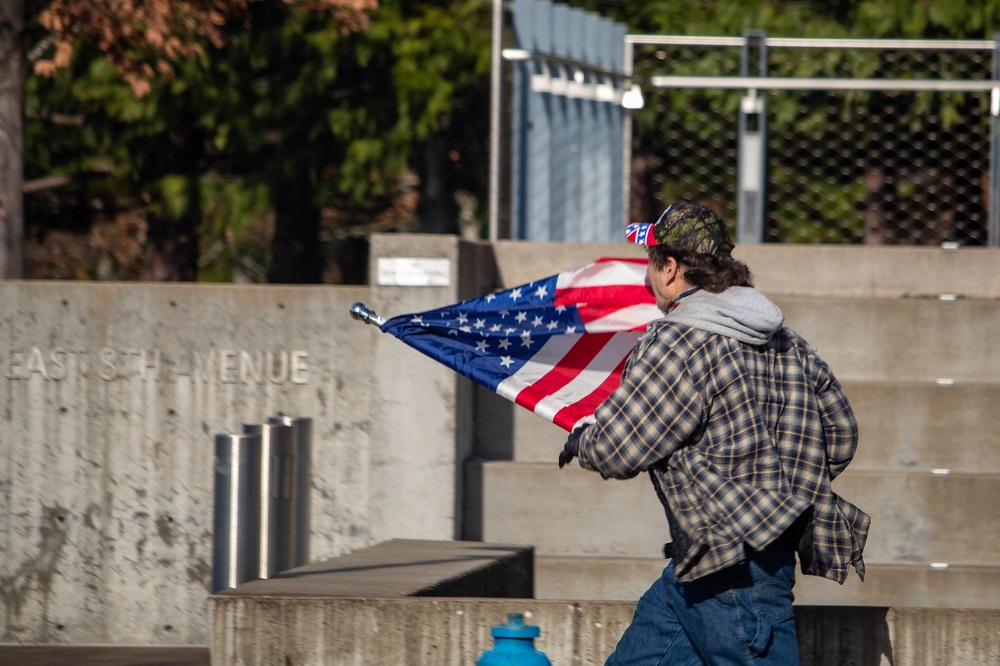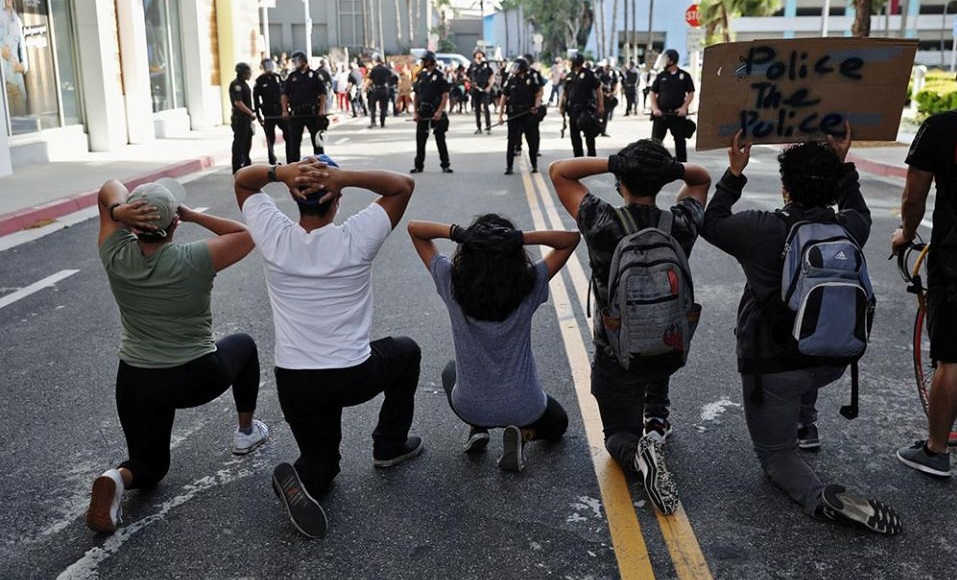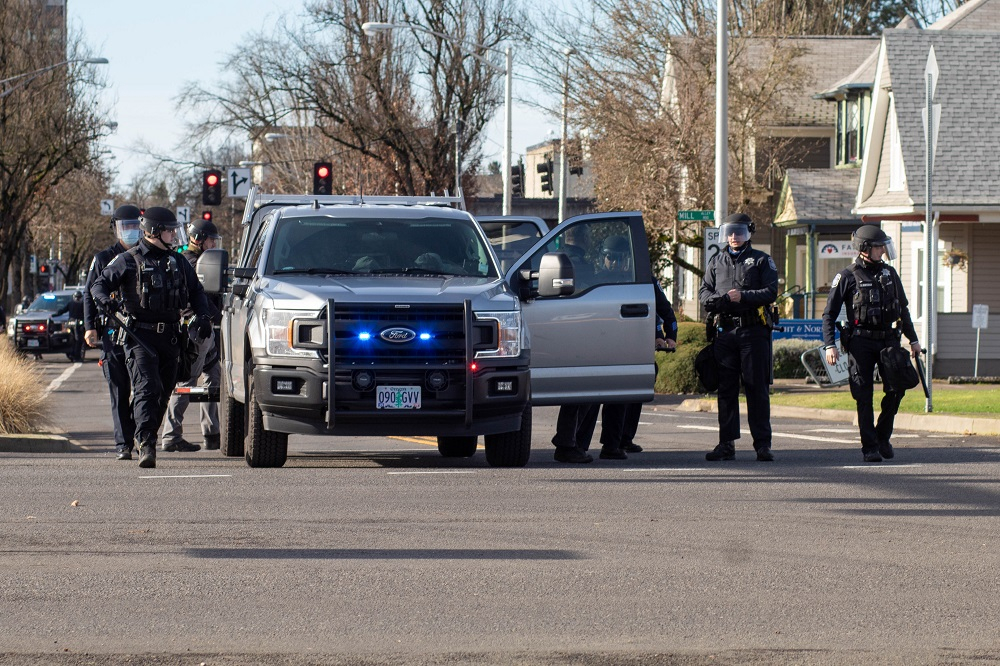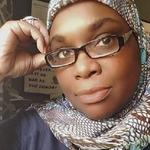Our White Supremacist-Laced History Doesn't End with a New Administration
Current Events
|
Jan 20, 2021
|
6 MIN READ

Image source: BBC on Twitter
It’s been two weeks since Trump-supporting insurrectionists stormed the U.S. Capitol, resulting in five deaths and several injuries. The event shook the nation and resurfaced historical white-rage violence once again unleashed on the nation, causing chaos and heightening fears. There are more than 20,000 national guard troops in Washington D.C. and increased security at President Joseph Biden’s inauguration.
Information revealed a planned attack on the federal building with the use of weapons. As surreal as it may have seemed to some, it was something unusual to the American experience.
The attempted insurrection prompted immediate chatter across social media, as it should. The thoughts and concerns of all Americans during situations like the turmoil last week, remains essential to our society and its cultural dialogue, even as a new administration takes control. Social media often provides a digital touchstone wherein people can connect. Sharing information and perspectives can be a great thing, especially since the country’s social structure resists people from different races and backgrounds creating lines of mutual cultural appreciation and humanization.
However, diverse spaces may also contain hazards that imperil true solidarity.
Insurrection 2021, the Past and Beyond
The Capitol insurrection is not a discrete event but a pattern of race-based rage perpetrated by white Americans throughout history. It represents one of a string of riots and massacres that imperiled the lives of Black and minority Americans. White miners murdered Chinese workers in the Rock Springs Massacre. Whites beat and killed African Americans during the East St. Louis Race Riot. U.S. servicemen formed mobs and attacked Latinos during the Zoot Suit Riots. Whenever whites sense an impact on their unearned privilege and see Blacks and Browns as people, many get agitated and angry.

An insurrectionist on January 6th in D.C.; image source: Wikimedia Commons
As a member of this society and mindset, former President Trump knew it and tapped into it. Rage-fueled white mob violence remains one aspect of the systemic layers of our nation’s white supremacist underpinnings that negatively affect minorities.
In addition, there is indoctrination into social systems and cultural rhetoric that props white supremacy and negates the experiences and humanity of people of color. No one is immune to this country’s racial rhetoric, which is ingrained into those who are native-born from birth. Media disseminates said racial rhetoric globally, influencing the mindsets of people outside of and immigrating into the country and ensuring that they embrace the racial hierarchy.
We all need to consciously appreciate the ways it influences us and actively resist – not an easy fete.
Not nearly enough people engage in the work necessary to recognize and purge ingrained and introduced rhetoric from their worldview and social dialogue, which results in delusions that feed racial biases. The violence we witnessed in the Capitol and the threats hanging over us as President Biden begins his term is evidence of this. We need to understand the beasts of white supremacy, anti-Blackness and xenophobia eating away at us as a nation and impeding our ability to truly come together as a diverse society.
Purging the Rhetoric that Fuels Hate
Times have changed since the white mob violence in the past. The ongoing arrests of the Capitol insurrectionists show a departure from previous massacres and riots that often resulted in financial devastation and death with little accountability. I would wax on the unique element about the insurrection in that it was whites attacking mainly white politicians and the country’s white-privileging government epicenter, but I do not want to digress.
The important point is that federal law enforcement is not letting anyone just go home and wrap themselves up in their treason.
Although the Feds are snatching up people who stormed the Capitol, they only represent a fraction of people indoctrinated into the racial dialogue that created them. We are all still saturated in a national racial discourse affecting how we interact. Consequently, it is not only racists, white nationalists and QAnon who engender the language and misconceptions about minorities or use them to weaponize the supremacist messages they grew up learning or to maintain social structures privileging them based on race.

Black Lives Matter protest; image source: Twitter
People across ethnicities and political affiliations also use the nation’s anti-Black and nativist idioms to protect their sensibilities about whiteness.
As so many in the country wag our social fingers at those with obvious supremacist machinations, whites need to become more socially astute and aware of ways that they may embrace the same ideologies and use them in spaces against people of color to defend whiteness. Every time there is a social uproar (and the exiting president has provided a lot of uproars) that makes it impossible for whites to ignore the terror-packed white supremacy realties saturating our country.
There will be those instilled with outrage. Unfortunately, indignation is never enough on its own, and many filled with it do not have enough education or social competency to traverse in social spaces with PoC and not cause emotional trauma or fall back on defending whiteness, something that is instilled in them.
White Muslims should also not hold any misconceptions that because they accepted Islam or may be married to a Black or Brown Muslim, they have cleansed themselves of indoctrinated white supremacist messages. Prophet Muhammad (saw) addressed the notions of racial superiority in his final speech, saying “A White has no superiority over a Black nor a Black has any superiority over a White except by piety and good action.”
The Prophet’s words reflect the existence of race-based mindsets among the Sahabiat (companions), the best generation of believers. They needed to engage in anti-racism to improve, which means that Muslims should continually strive to recognize it in themselves. Until they do, they should at least hesitate to inject their potentially harmful perspectives into spaces with already traumatized Muslims of color.
Don’t get me wrong. Open dialogue across racial and ethnic backgrounds can be wonderful, but for PoC, whites – who remain deluded by the rhetoric training them to consider themselves above race and as saviors descending upon those Blacks and Browns beneath them – can inflict as much damage as the most ardent Trump supporter. The discourses between PoC and moderate or liberal white is often no safer.
When Subtle Racism Infiltrates Social Media
Social media are often spaces where PoC often encounter subtle white supremacist rhetoric and messaging. Whenever there is racial turmoil I usually scroll through multiple platforms. Almost without fail, I will see a comment under a PoC’s post from a white person attempting to invalidate their experience or perspective. I rarely get such foolishness on my posts because I established zero white nonsense on my feed years ago, but I have noticed the implementation of white supremacist rhetoric on other minorities, especially Muslim women of color. It is so commonplace that I come to expect it.
Like clockwork after the insurrection at the Capitol two weeks ago, I came across comments from white and mostly white women on the posts of Muslim women of color. The language is often more subtle than the hate-laced touting of the Trump supporters on the screen, but it is just as dismissive.

Police patrol the streets of D.C.; image source: Wikimedia Commons
A couple of comments struck me on one Facebook post hours after insurrectionists stormed the Capitol, searching for Congresspeople. When one Muslim WoC mentioned the probability that the storming was an inside job, a white woman warned her to be “Be careful not to believe in conspiracy theories.” At face value, the statement may appear innocuous, but it comes from a perspective disparate from the experiences of many people of color with law enforcement.
The dismissive relegation of the Muslim woman’s concerns as “conspiracy theory” is standard rhetoric that attempts to negate the reality that they do exist, especially for people of color. There is a history of known conspiracies in law enforcement to suppress minority groups seeking social justice and those perceived as potential threats. But too many white people don’t know this.
The infiltration of the Black Muslim Movement, the government targeting the Black Panther Party and American Indian Movement through COINTELPRO, and the NYPD spying on Muslims that extended into Pennsylvania, Connecticut, New Jersey and Long Island demonstrate the complicit and incendiary relationship that law enforcement has with PoC in this country.
People across races and backgrounds want to see increased justice and solidarity for everyone, but it requires work and education. As much as we might want to place all the blame for the country’s current racial client on one man, the former president did not create the problems. Sure, he brought white racist tensions to the surface and capitalized on people deluded by a false sense of superiority and entitlement. But, he didn’t teach it to them; our social structure did.
Good intentions notwithstanding, whites – the beneficiaries of racism and colonialism – need to generate inner self-awareness about indoctrinated racial elements they may still implement and seek to educate themselves on how they can purge white supremacist rhetoric before inflicting it on people of color.
As our new president, Joseph Biden said in his inauguration speech, “America can do better than this.”
Subscribe to be the first to know about new product releases, styling ideas and more.
What products are you interested in?

